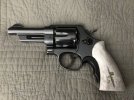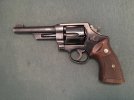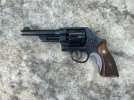L Ross
Well-Known Member
I've always like the look of N frames and have owned a few. Two 28's, two 29's, and a 57. All gone, just too big and heavy for belt carry for a guy my size. Oh, I almost forgot. There is a 1938 Brazilian .45 acp/auto rim still lolly gagging around a safe. Also under the category of too big to carry is a long barreled New Service in .38 w.c.f. Maybe if I'd find myself a Mountiesque Sam Brown flap holstered, oh who am I kidding? If I'm gonna carry a belt gun it had better be pretty unobtrusive and not so precious that if the grips get scratched or some other mishap befalls it the amount of tears will be minimal.
Nothing wrong with nostalgia and I'm sure there are some strappin' big fellas that can stick an N frame in an inside the waist band or pancake rig and wear it all day, but not me. If I feel the need for a 160 grain SWC at 1,200 fps I can just tolerate my late 1950's Ruger flat top 4 5/8". If I get a chance at some varmint up on the ridge my ears will ring extra loud for two days with that. Plus I'd not want to scratch that up or worse chip a grip. Otherwise it's a 3" Model 60 in stainless with Ed's full wadcutter load for work-a-day packin' with rubber grips.
That hard chromed .38-44 looks like a true workin' gun. How's the sight picture Ric? A man could get near .357 performance out of dirt common .38 spl brass and not worry about a crud ring in the longer chamber of a .357.
Nothing wrong with nostalgia and I'm sure there are some strappin' big fellas that can stick an N frame in an inside the waist band or pancake rig and wear it all day, but not me. If I feel the need for a 160 grain SWC at 1,200 fps I can just tolerate my late 1950's Ruger flat top 4 5/8". If I get a chance at some varmint up on the ridge my ears will ring extra loud for two days with that. Plus I'd not want to scratch that up or worse chip a grip. Otherwise it's a 3" Model 60 in stainless with Ed's full wadcutter load for work-a-day packin' with rubber grips.
That hard chromed .38-44 looks like a true workin' gun. How's the sight picture Ric? A man could get near .357 performance out of dirt common .38 spl brass and not worry about a crud ring in the longer chamber of a .357.



